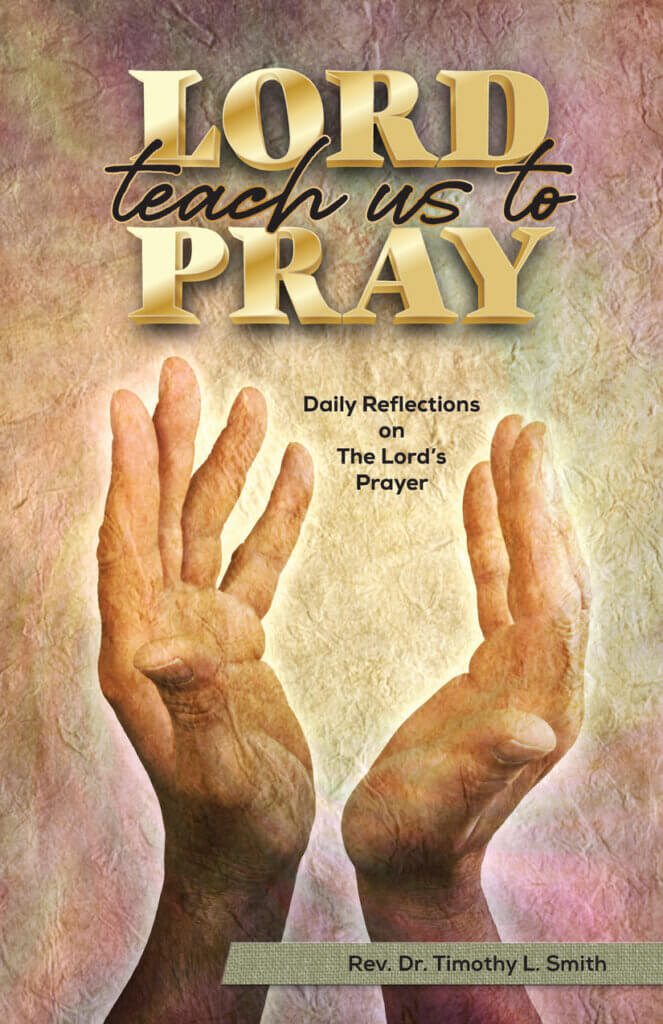“Jesus was praying in a certain place, and after he had finished, one of his disciples said to him, ‘Lord, teach us to pray…’”
(Luke 11:1)
“Pray then in this way.”
(Matthew 6:9)
Do you ever struggle with prayer? Do you struggle for the right words to say, or how to pray according to God’s will? Then count yourself among the greatest of saints who talk of their own struggles with prayer. As Scripture tells us, even Jesus’ disciples asked Him to teach them how to pray. In this series of reflections we will explore what is called The Lord’s Prayer, a wondrous gift that Jesus bestowed on His disciples, and all of us who ask Him: “Lord, teach us to pray…” (Luke 11:1).
Jesus’ disciples had seen something in the way Jesus prayed that made them want to learn from Him how to pray. It is meaningful that they did not ask Jesus how to perform miracles, like walking on water or raising the dead. They wanted to learn from Him how to pray! They saw prayer as essential to Jesus’ life and ministry.
In asking Jesus to teach them how to pray, we must not think that His disciples knew little about prayer; they were hardly beginners at praying. As first century religious Jews, they were praying people. They would have learned at their mothers’ knees to pray the Shema, Israel’s statement of faith, first thing in the morning and again at night before they closed their eyes. Also, as little children they would have been taught to pray the Amida, consisting of eighteen blessings, morning, afternoon and night. They would have added prayers as they worshipped at the local synagogue, known as beit tefilla, “house of prayer”. Some of these disciples had been followers of John the Baptist who taught his disciples how to pray (Luke 11:1). Jesus’ disciples are hardly novices at prayer, and yet long to know how Jesus prays.
In gifting His disciples with The Lord’s Prayer, the Lord Jesus invites: “Follow me.” With this prayer we will enter into the heart and mind of Jesus, learning how He looks at life and the world. Theologian J. I. Packer rightly says of the prayer Jesus teaches: “What it means to be a Christian is nowhere clearer than here.” (J. I. Packer, Praying The Lord’s Prayer) New Testament scholar Joachim Jeremias notes that The Lord’s Prayer “is the clearest and, in spite of its terseness, the richest summary of Jesus’ proclamation which we possess.” (Joachim Jeremias, The Lord’s Prayer) Church father Tertullian sums up the sentiment of early Christians about The Lord’s Prayer, saying that in it “there is contained an abridgement of the entire Gospel.” (Tertullian, Prayer)
The importance of The Lord’s Prayer to Jesus’ first followers is seen in the first century Christian document Didache (“Teaching”), which reports early Christians praying The Lord’s Prayer morning, afternoon and night. Christians, for 2,000 years since, have found The Lord’s Prayer powerful for transforming lives into the likeness of the One who teaches how to pray.
• IT IS A FAMILY PRAYER
As we pray The Lord’s Prayer, we quickly learn that we are not praying as lone individuals, but as members of a family, Jesus’ family. We recognize Jesus’ family emphasis in His repeated first-person-plural pronouns: “Our– us – our – us – our – we – us – us”. The words of this prayer unite us as Jesus’ family. What a difference it makes for us to pray “Our Father”, and not “My Father”! We are members of God’s worldwide praying family, praying even with the saints of heaven who bend down to join their hearts and voices with us, “Our Father…”.
• IT IS A PRAYER OF ORDER
There is discernable order in The Lord’s Prayer: first, the Father, then the Father’s family, concluding with a doxology of praise. The first part of the prayer is about our Father, the hallowedness of His name, His kingdom, and His will being done. The three Father Petitions then flow into the second part of the prayer, the Family Petitions: our need for daily bread, daily forgiveness, and God’s leading and deliverance from evil. When we have first aligned ourselves with Father’s kingdom, it is necessary and fitting to pray for the practical needs of Father’s family. We then finish with a doxology of praise to Father’s kingdom, power, and glory.
• IT IS A SHORT PRAYER
People are often surprised at how short, simple and to the point The Lord’s Prayer is. No excess words here. Jesus did, after all, warn us against long-winded praying (Matthew 6:7). Martin Luther was also known for powerful praying, but taught economy of words: “One should pray short but often and strongly; for God does not ask how much and long one has prayed, but how good it is and how it comes from the heart.” (Martin Luther, Commentary on the Sermon on the Mount) Many Christians like to pray The Lord’s Prayer several times throughout the day. Luther’s advice of “short” – “often” — “strongly” — contains wise words for us as we take up daily praying with our Lord.
Praying the Lord’s Prayer
Throughout this devotional you will be encouraged to pray The Lord’s Prayer three times each day. Here are a few ways that others have found helpful in praying The Lord’s Prayer.
- Pray The Lord’s Prayer reciting it slowly line by line. Take time to pause and savor each phrase: “Our Father…who art in heaven…hallowed be your name…”.
- Another way of praying The Lord’s Prayer is to follow the Spirit’s prompting to expand on a phrase. For instance, when praying “Your will be done on earth…”, you might sense the Spirit directing you to a specific way God wants His will done in your life. Or, when praying “Forgive us our sins…”, be aware of how the Holy Spirit might be pointing you to a specific sin in your life needing forgiveness.
- Experiment with taking a phrase from The Lord’s Prayer and making that phrase your ‘Prayer of the Day’. For example, you might want to take the prayer for our daily bread and throughout the day specifically pray for the many who do not have bread today.
I have found it helpful to think of The Lord’s Prayer like a check requiring two signatures. Jesus pens the first signature, entrusting to us what He wants us to pray. You and I are the second needed signatures: Jesus awaits our prayer. And as we pray, we pen the second signatures, becoming co- workers with Jesus. We hallow our Father’s name in the world and bring in His Kingdom.
The Text of The Lord’s Prayer
• THE TWO VERSIONS
As you read the Gospels you discover that Jesus taught The Lord’s Prayer at least two different times; one is recorded in Matthew 6:9-13 and one in Luke 11:2-4. If you compare the two different recordings of the prayer you will see differences in both wording and length. These differences
suggest that Jesus is teaching us principals of prayer rather than word-for- word repetition. Jesus did instruct us “Pray in this way…” (Matthew 6:9), suggesting that The Lord’s Prayer is a template for prayer.
We look to how early Christians prayed The Lord’s Prayer; the Didache shows the early Christians praying the longer Matthew version of the prayer. Thus, it is the Matthew version that comes down to us through the centuries and is prayed around the world. It is the version used in this devotional.
• TRESPASSES, DEBTS, AND SINS
Which wording will we use in this devotional? Will we ask Father to forgive our “trespasses”, “debts”, or “sins”? If you are from the Reformed tradition of Christianity, you likely pray for Father to forgive our “debts”. If you are Methodist, Anglican, Episcopalian, or Roman Catholic, you probably ask forgiveness for “trespasses”. If you have been influenced by recent inter-denominational movements, you likely ask forgiveness for “sins”. Most scholars acknowledge that you can pray interchangeably “trespasses”, “debts”, and “sins.” For this devotional we will ask forgiveness for our “sins”.
• THE DOXOLOGY
Perhaps you have prayed The Lord’s Prayer in a church that omitted the doxology “for thine is the kingdom, the power, and the glory for ever and ever.” If you look at any modern translation of the Gospels (e.g., Revised Standard Version, New International Version, Living Bible), you will see that the doxology is not included in The Lord’s Prayer. That is because the doxology is not found in the oldest and best Greek manuscripts and, therefore, is not regarded as a part of Jesus’ prayer. Yet again, the first century Didache shows early Christians adding the doxology to The Lord’s Prayer. That is probably because the earliest Christians were Jews who would commonly end prayers with variations of King David’s doxology in 1 Chronicles 29:11.
But, in adding David’s doxology early Christians were adding the words of Scripture. So, regarding the doxology, we might conclude: “In any case, it chimes in exactly with the message of the prayer as a whole: God’s kingdom, God’s power, and God’s glory are what it is all about.” (N. T. Wright, The Lord and His Prayer) To that early Christians added their “Amen”, the confident assent of believers in New Testament times (1 Corinthians 14:16).
We invite you again, as you read and reflect through each day of this devotional, to PRAY THE LORD’S PRAYER (Morning – Noon – Night)



